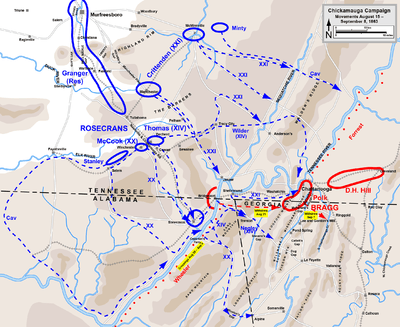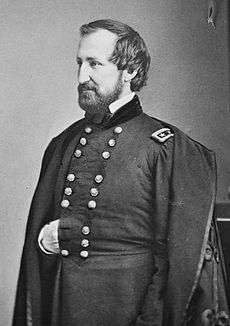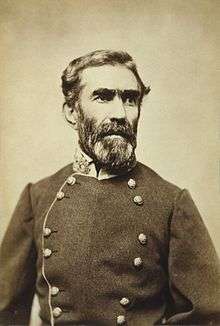Chickamauga campaign
The Chickamauga campaign of the American Civil War was a series of battles fought in northwestern Georgia from August 21 to September 20, 1863, between the Union Army of the Cumberland and Confederate Army of Tennessee. The campaign started successfully for Union commander William S. Rosecrans, with the Union army occupying the vital city of Chattanooga and forcing the Confederates to retreat into northern Georgia. But a Confederate attack at the Battle of Chickamauga forced Rosecrans to retreat back into Chattanooga and allowed the Confederates to lay siege to the Union forces.

Background
In his successful Tullahoma campaign in the summer of 1863, William S. Rosecrans moved southeast from Murfreesboro, Tennessee, outmaneuvering Braxton Bragg and forcing him to abandon Middle Tennessee and withdraw to the city of Chattanooga, suffering only 569 Union casualties along the way.[1] Union general-in-chief Maj. Gen. Henry W. Halleck and President Abraham Lincoln were insistent that Rosecrans move quickly to take Chattanooga. Seizing the city would open the door for the Union to advance toward Atlanta and the heartland of the South. Chattanooga was a vital rail hub (with lines going north toward Nashville and Knoxville and south toward Atlanta), and an important manufacturing center for the production of iron and coke, located on the navigable Tennessee River. Situated between Lookout Mountain, Missionary Ridge, Raccoon Mountain, and Stringer's Ridge, Chattanooga occupied an important, defensible position.[2]
Although Braxton Bragg's Army of Tennessee contained about 52,000 men at the end of July, the Confederate government merged the Department of East Tennessee, under Maj. Gen. Simon B. Buckner, into Bragg's Department of Tennessee, which added 17,800 men to Bragg's army, but also extended his command responsibilities northward to the Knoxville area. This brought a third subordinate into Bragg's command who had little or no respect for the commanding general.[3] Lt. Gen. Leonidas Polk and Maj. Gen. William J. Hardee had already made their animosity well known. Buckner's attitude was colored by Bragg's unsuccessful invasion of Buckner's native Kentucky in 1862, as well as by the loss of his command through the merger.[4] A positive aspect for Bragg was Hardee's request to be transferred to Mississippi in July, but he was replaced by Lt. Gen. D.H. Hill, a general who did not get along with Robert E. Lee in Virginia.[5] The Confederate War Department asked Bragg in early August if he could assume the offensive against Rosecrans if he were given reinforcements from Mississippi. He demurred, concerned about daunting geographical obstacles and logistical challenges, preferring to wait for Rosecrans to solve those same problems and attack him.[6] He was also concerned about a sizable Union force under Maj. Gen. Ambrose E. Burnside that was threatening Knoxville. Bragg withdrew his forces from advanced positions around Bridgeport, which left Rosecrans free to maneuver on the northern side of the Tennessee River. He concentrated his two infantry corps around Chattanooga and relied upon cavalry to cover his flanks, extending from northern Alabama to near Knoxville.[7]
Opposing forces
| Opposing commanders |
|---|
|
Union
Confederate
Battles
Second Chattanooga
(August 21, 1863)
Rosecrans ordered a brigade to shell Chattanooga from the western side of the Tennessee River and skirmish with the main Confederate force in the city to divert attention away from the flanking column sent southwest of the city. Other Union units were deployed along the river to the east. The diversion was successful, with Bragg concentrating his army east of Chattanooga. After concluding that his position was untenable, Bragg abandoned the city on September 6 and retreated into northern Georgia.[8]
Davis's Cross Roads
(September 10–11, 1863)
Bragg intended to attack General James S. Negley's isolated division of the Union XIV Corps, commanded by George H. Thomas, before Rosecrans could concentrate the rest of his army at that location. He ordered the divisions of Thomas Hindman and Patrick Cleburne to concentrate together and launch a joint attack under Hindman's command. Due to delays in conveying orders, Cleburne's division failed to arrive in time on the 10th, while Thomas reinforced the isolated division with the rest of his corps. After the two divisions were united the next day, they failed to launch a coordinated attack on Thomas' positions and were repulsed.[9]
Chickamauga
(September 19–20, 1863)
Believing that Thomas L. Crittenden's XXI Corps was isolated from the rest of the Union army, Bragg ordered his army to concentrate near Lee's and Gordon's Mills; however, Rosecrans had been concentrating his army along Chickamauga Creek. Detachments from Thomas' Corps and Confederate cavalry collided on September 19, with both commanders feeding reinforcements into the engagement. The day ended without a clear victory by either side. The next day, Bragg ordered attacks in an echelon formation starting with the left flank at dawn but Polk, commanding the Confederate left wing, failed to properly supervise his command. The attacks began four hours late and failed to dislodge the Union army from its positions. Shortly after 11 a.m., an attack by Longstreet's corps struck a gap in the Union line, routing most of the Union army. Thomas formed his corps on Snodgrass Hill and held off further Confederate attacks for the remainder of the afternoon before retreating back to Chattanooga near sundown.[10]
Aftermath
Rosecrans retreated into Chattanooga after the battle of Chickamauga. Reinforcements were sent from the Army of the Tennessee and the Army of the Potomac. Both Crittenden and Alexander McCook, commander of the XX Corps, were replaced on September 28 for alleged misconduct at Chickamauga, although they were both cleared of the charge. U.S. Grant, recently made commander of the Military Division of the Mississippi and placed in command of the Union forces near Chattanooga, decided to replace Rosecrans with Thomas on October 19.[11]
At the time of Chickamauga, the Army of Tennessee was suffering from a shortage of food and of wagons to transport supplies; it also lacked pontoon bridges to cross the Tennessee River. Bragg consequently decided to lay siege to the Union army.[12] The Confederates occupied Missionary Ridge and spread a picket line along the south bank of the river towards Alabama. Fire from Confederate sharpshooters prevented supply wagons from reaching Chattanooga.[13]
See also
- Troop engagements of the American Civil War, 1863
- List of costliest American Civil War land battles
- List of American Civil War battles
- Western Theater of the American Civil War
- Tullahoma campaign
- Timeline of events leading to the American Civil War
- Commemoration of the American Civil War on postage stamps
Notes
- Lamers, p. 289.
- Korn, p. 32; Cozzens, pp. 21–23, 139; Eicher, p. 577; Woodworth, pp. 12–13; Lamers, p. 293; Kennedy, p. 226.
- Cozzens, pp. 87–89; Tucker, pp. 81–82.
- Hallock, p. 44; Cozzens, pp. 156–58.
- Cozzens, p. 155.
- Woodworth, p. 50.
- Woodworth, p. 53; Hallock, pp. 44–45; Lamers, p. 138; Cozzens, pp. 163–65.
- Cozzens, p. 36–37, 55.
- Cozzens, pp. 65–75.
- Kennedy, pp. 227–231.
- Cozzens, pp. 522–523, 525, 527.
- Connelly, pp. 230–233.
- Bowers, p. 175.
References
- Bowers, John. Chickamauga and Chattanooga: The Battles That Doomed the Confederacy. New York: HarperCollins, 1994. ISBN 0-06-016592-8.
- Connelly, Thomas Lawrence. Autumn of Glory: The Army of Tennessee, 1862–1865. Baton Rouge, Louisiana: Louisiana State University Press, 1971. ISBN 0-8071-0445-0.
- Cozzens, Peter. This Terrible Sound: The Battle of Chickamauga. Urbanna, Illinois: University of Illinois Press, 1992. ISBN 0-252-02236-X.
- Eicher, David J., The Longest Night: A Military History of the Civil War. New York: Simon & Schuster, 2001, ISBN 0-684-84944-5.
- Hallock, Judith Lee, Braxton Bragg and Confederate Defeat, volume II. Tuscaloosa, Alabama: University of Alabama Press, 1991. ISBN 0-8173-0543-2.
- Kennedy, Frances H., Ed., The Civil War Battlefield Guide, 2nd ed. New York: Houghton Mifflin Co., 1998. ISBN 0-395-74012-6.
- Korn, Jerry, and the Editors of Time-Life Books, The Fight for Chattanooga: Chickamauga to Missionary Ridge. Alexandria, Virginia: Time-Life Books, 1985. ISBN 0-8094-4816-5.
- Lamers, William M., The Edge of Glory: A Biography of General William S. Rosecrans, U.S.A.. Baton Rouge, Louisiana: Louisiana State University Press, 1961, ISBN 0-8071-2396-X.
- Powell, David A. Failure in the Saddle: Nathan Bedford Forrest, Joe Wheeler, and the Confederate Cavalry in the Chickamauga Campaign. Savas Beatie, 2010. ISBN 978-1932714876.
- Powell, David A. The Chickamauga Campaign, A Mad Irregular Battle: From the Crossing of Tennessee River Through the Second Day, August 22-September 19, 1863. Savas Beatie, 2015. ISBN 978-1611211740.
- Powell, David A. The Maps of Chickamauga: An Atlas of the Chickamauga Campaign, Including the Tullahoma Operations, June 22-September 23, 1863. Savas Beatie, 2009. ISBN 978-1932714722.
- White, Lee. Bushwhacking on a Grand Scale: The Battle of Chickamauga, September 18–20, 1863 (Emerging Civil War series), Savas Beatie, 2013. ISBN 978-1611211580.
- Tucker, Glenn. Chickamauga: Bloody Battle in the West. Indianapolis, Indiana: Bobbs-Merrill Company, 1961.
- Woodworth, Steven E., Six Armies in Tennessee: The Chickamauga and Chattanooga Campaigns. Lincoln, Nebraska: University of Nebraska Press, 1998. ISBN 0-8032-9813-7.
External links
| Wikimedia Commons has media related to Battle of Chickamauga. |
| Wikimedia Commons has media related to Chickamauga and Chattanooga National Military Park. |
| Wikimedia Commons has media related to National Register of Historic Places in Catoosa County, Georgia. |
- Battle of Chickamauga: Battle Maps, histories, photos, and preservation news (Civil War Trust)
| Wikisource has the text of an 1879 American Cyclopædia article about Battle of Chickamauga. |
- Animated map of the Battle of Chickamauga (Civil War Trust)
- The Battle of Chickamauga, Union reports
- The Battle of Chickamauga, Confederate reports
- National Park Service Chickamauga and Chattanooga National Military Park
- Official Records: The Battle of Chickamauga
- The Battle of Chickamauga at Civil War Virtual Tours
- Ambrose Bierce's short story, "Chickamauga"
- Local Legends of Tennessee
- Animated History of the Battle of Chickamauga
- The Battle of Chickamauga: An Alabama Infantry Regiment's Perspective
- General G.H. Thomas – The Rock of Chickamauga was very quick getting into position

